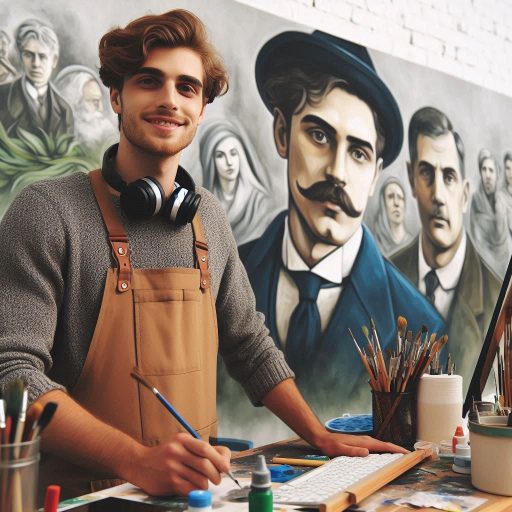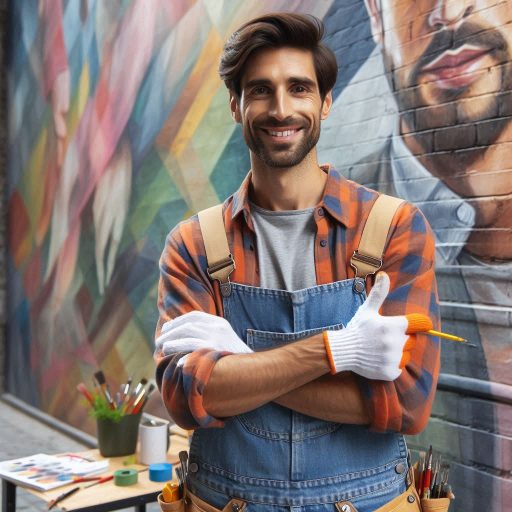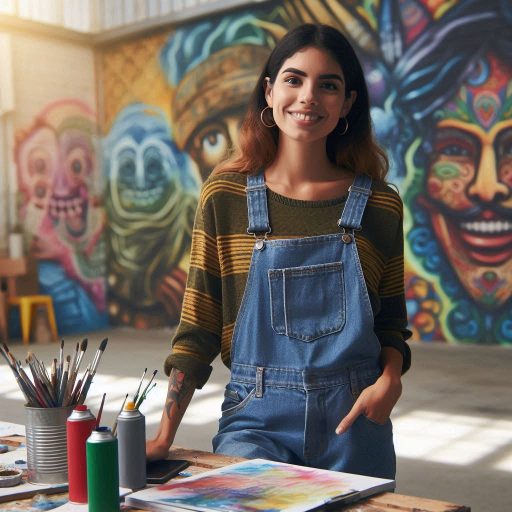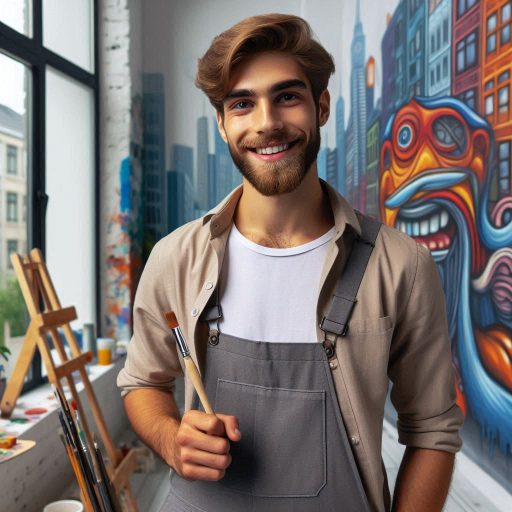Introduction
Stunning mural designs have the power to transform any space, adding character and visual interest.
Finding inspiration sources is essential for creating these impactful artworks.
A well-designed mural not only enhances a space but also communicates a story or concept.
By incorporating vibrant colors, bold patterns, or cultural elements, murals can dramatically elevate the aesthetic appeal of any environment.
Mural designs can enhance both interior and exterior spaces by:
- Adding depth and dimension to walls.
- Reflecting personal or cultural identity.
- Creating a focal point in a room or outdoor area.
- Invoking emotions through color and imagery.
For artists, drawing inspiration from diverse sources can unlock creativity.
These sources might include nature, architecture, historical art movements, or urban landscapes.
By exploring different themes, artists can craft murals that resonate with viewers and bring uniqueness to the space they adorn.
Inspiration drives the creative process, ensuring each mural becomes a stunning visual masterpiece.
Nature
How nature can serve as a great inspiration source for stunning mural designs
Nature is a boundless source of inspiration for stunning mural designs.
The beauty and diversity found in nature can fuel creativity and provide endless possibilities for unique and captivating artwork.
Examples of how elements can be incorporated into mural designs
Elements like trees can be incorporated into mural designs to add a sense of height and majesty to a space.
Flowers, with their vibrant colors and intricate shapes, can bring a touch of elegance and beauty to any mural.
Landscapes, from serene meadows to breathtaking mountain ranges, can create a sense of depth and perspective in a mural.
The calming and soothing effect nature-inspired murals can have on a space
Nature-inspired murals have a calming and soothing effect on a space, making them ideal for creating a peaceful and serene environment.
The use of natural elements in mural designs can help connect people to the beauty of the outdoors, even when they are indoors.
Whether it’s a peaceful forest scene or a vibrant floral display, nature-inspired murals can transform any space into a tranquil oasis of beauty and serenity.
Read: Public vs. Private Murals: Key Differences Explained
Urban Landscapes
Exploring Urban Landscapes for Mural Inspiration
Urban landscapes are a treasure trove of inspiration for mural designs, offering a blend of architectural marvels, bustling streets, and vibrant culture.
When artists look towards city settings for creative fuel, they often find an endless array of ideas waiting to be translated onto walls.
Transform Your Career Today
Unlock a personalized career strategy that drives real results. Get tailored advice and a roadmap designed just for you.
Start NowInfluence of City Skylines, Buildings, and Street Art
City skylines are iconic features that can serve as striking focal points in mural designs.
The silhouette of skyscrapers against the sky, especially during sunset or sunrise, can create a breathtaking visual impact.
Buildings, both historic and contemporary, contribute to the unique character of a city and can be incorporated into murals to celebrate the urban landscape.
Street art, with its raw and expressive nature, has long been a source of inspiration for muralists.
Graffiti, murals, and other forms of urban art can influence the color palette, style, and themes of mural designs.
By taking cues from street art, artists can infuse their murals with a sense of authenticity and edginess that resonates with city dwellers.
Bringing a Modern and Dynamic Feel to Spaces
By incorporating elements of urban landscapes into mural designs, artists can transform a space into a dynamic and contemporary environment.
Whether it’s a busy city street depicted on a wall or a stylized rendition of a skyline, these murals can breathe life into ordinary spaces, infusing them with energy and character.
The juxtaposition of traditional mural techniques with urban motifs can create a visual dialogue that speaks to the evolving nature of cities.
This fusion of old and new, of history and innovation, adds depth and complexity to mural designs, making them more compelling and relevant to the urban setting.
Ultimately, urban landscapes offer a wealth of inspiration for muralists, pushing them to explore new themes, experiment with different styles, and engage with the dynamic spirit of cities.
By drawing from the sights, sounds, and textures of urban environments, artists can create murals that not only beautify spaces but also reflect the essence of modern city life.
Cultural Heritage
Importance of drawing inspiration from cultural heritage for mural designs
Drawing inspiration from cultural heritage enriches mural designs significantly.
It connects artists to their roots and honors traditions.
Cultural heritage reflects unique histories, values, and beliefs.
When artists incorporate these elements, they create murals with depth and meaning.
How traditional patterns, symbols, and motifs can be incorporated into murals
Traditional patterns, symbols, and motifs serve as powerful design elements.
Each culture has its distinct visual language, offering endless inspiration.
Artists can integrate tribal patterns, historical symbols, or folkloric motifs into their murals.
These elements tell stories and convey messages that resonate with viewers.
Transform Your Career Today
Unlock a personalized career strategy that drives real results. Get tailored advice and a roadmap designed just for you.
Start NowFor example, Indigenous designs can celebrate the land and its history.
Similarly, African motifs can highlight community and resilience.
How celebrating cultural heritage through murals can promote diversity and inclusivity
Celebrating cultural heritage through murals promotes diversity and inclusivity.
Murals act as public art that reflects the community’s multicultural fabric.
When artists showcase various heritages, they foster appreciation and understanding among different groups.
These murals invite dialogue, allowing people to share their stories and experiences.
Additionally, murals that celebrate cultural heritage can beautify urban spaces.
They transform bland walls into vibrant canvases that tell collective stories.
Communities often feel a sense of pride and ownership when their heritage is represented.
This connection to cultural roots can also inspire younger generations to embrace their identities.
In short, drawing inspiration from cultural heritage enhances mural designs.
By incorporating traditional patterns, symbols, and motifs, artists create meaningful art.
These murals celebrate diversity and inclusivity, enriching communities and promoting understanding.
Through cultural representation, murals become powerful tools for connection and expression.
Read: How to Find Clients as a Freelance Mural Artist
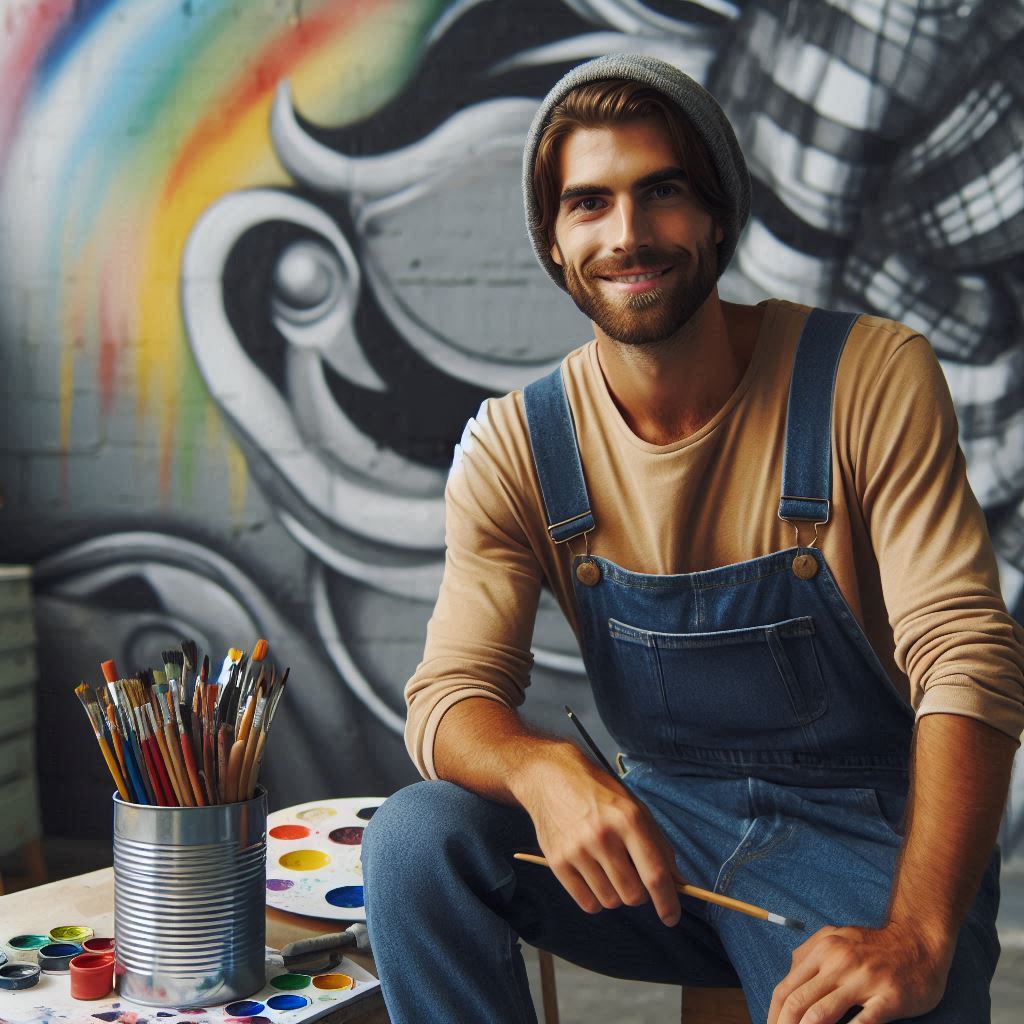
Art History
How studying art history can provide valuable inspiration for creating stunning mural designs
Studying art history opens a world of inspiration for mural designs.
It allows artists to understand various techniques, themes, and cultural contexts.
Knowledge of art movements enriches an artist‘s perspective, helping them create murals that resonate deeply.
How different art movements and styles can be used as references for mural projects
Different art movements, like Impressionism and Surrealism, offer unique visual styles.
Impressionism, with its focus on light and color, inspires vibrant mural palettes.
Transform Your Career Today
Unlock a personalized career strategy that drives real results. Get tailored advice and a roadmap designed just for you.
Start NowArtists can capture fleeting moments, bringing energy to their designs.
Surrealism encourages creativity through dreamlike imagery.
Murals can reflect this movement‘s imaginative elements, inviting viewers into fantastical worlds.
Examples of how famous artworks or artists have influenced mural designs
Famous artworks and artists serve as powerful references.
For example, the bold colors of Henri Matisse can inspire modern muralists to embrace vibrancy.
His cut-outs translate well into large-scale designs, creating impactful visual statements.
Similarly, the dynamic forms of Pablo Picasso’s Cubism can inspire innovative compositions in murals.
Artists can break traditional boundaries and explore new perspectives.
Street art also draws from art history.
Many contemporary muralists incorporate elements from the Renaissance or Baroque periods.
They reinterpret classical techniques to create modern expressions.
For instance, murals that mimic frescoes can evoke a sense of timelessness while still appearing contemporary.
In addition, artists can explore regional art traditions.
Mexican muralists, like Diego Rivera, infused cultural narratives into their work.
This approach encourages modern muralists to tell local stories through their designs.
Ultimately, studying art history equips artists with tools to create stunning murals.
By understanding past movements and influences, they can craft visually compelling narratives.
This rich knowledge enhances creativity and elevates mural art to new heights.
Read: Understanding the Business Side of Mural Art
Personal Experiences
Incorporating personal experiences into mural designs can transform a project into a deeply meaningful work of art.
Transform Your Career Today
Unlock a personalized career strategy that drives real results. Get tailored advice and a roadmap designed just for you.
Start NowBy drawing from your own life, you create unique, compelling murals that resonate emotionally with viewers.
Here‘s how to harness your personal experiences to create stunning murals:
Draw Inspiration from Memories and Life Events
Personal memories often hold powerful imagery.
Whether it‘s childhood moments or life-changing events, these memories provide rich, authentic material for your designs.
Reflect on experiences that have shaped who you are, then translate them into your mural.
Examples of memory-based ideas:
- A vacation that gave you peace or excitement
- A pivotal moment that changed your life trajectory
- Nostalgic feelings of home, family, or cultural heritage
Use Emotions and Relationships
Emotions give art depth and dimension.
Tap into feelings of joy, love, grief, or hope, and channel them into your mural.
Likewise, relationships with loved ones‘whether family, friends, or mentors‘can inspire dynamic design elements.
Key emotional experiences to consider:
- Love and connection with others
- Overcoming personal challenges
- Feelings that define pivotal moments in your life
Transform Significant Events into Art
Major life events often spark creativity.
Weddings, graduations, new beginnings, or even losses are emotionally charged and can be expressed through colors, shapes, and symbols in a mural.
Tips for Infusing Personal Touches
To add personal touches to your mural:
- Include symbols or icons that represent key aspects of your story
- Use a color palette that reflects your mood or memories
- Add subtle patterns or textures tied to meaningful locations or objects
By weaving your personal experiences into your mural designs, you‘ll create more profound and meaningful art that resonates with both you and your audience.
Read: Step-by-Step Guide to Creating Your First Mural
Social Issues
When it comes to creating stunning mural designs, drawing inspiration from social issues can be a powerful and meaningful source.
Here’s how:
Role of murals in raising awareness about social issues and promoting change
Murals play a crucial role in raising awareness about social issues.
They can act as visual reminders of the struggles and injustices present in society.
Through their depiction of social issues, murals have the potential to spark conversations.
Transform Your Career Today
Unlock a personalized career strategy that drives real results. Get tailored advice and a roadmap designed just for you.
Start NowThey serve as a platform for artists to voice their concerns and advocate for change.
How themes such as equality, justice, and environmental conservation can inspire mural designs
Themes such as equality, justice, and environmental conservation can inspire mural designs.
Equality-themed murals can showcase diversity and inclusion in communities.
Justice-focused murals can highlight the fight against discrimination and oppression.
Environmental conservation themes can raise awareness about sustainability and eco-conscious living.
The power of murals in sparking conversations and fostering community engagement
Murals have the power to spark conversations and encourage dialogue on social issues.
They can serve as a visual call to action, inspiring people to take a stand for positive change.
By addressing social issues, murals can foster community engagement and unity.
They provide a platform for marginalized voices to be heard and represented in public spaces.
Overall, murals inspired by social issues have the ability to not only beautify urban landscapes but also serve as powerful tools for advocacy, awareness, and social change.
Discover More: Crafting Compelling Visual Narratives as an Art Director
See Related Content: Developing Your Creative Director Style
Collaboration
Benefits of collaborating with other artists, designers, or community members for mural projects
Collaboration is vital in creating stunning murals.
Working with other artists, designers, or community members brings diverse ideas to the table.
This variety enhances creativity and encourages unique expressions in mural art.
When artists collaborate, they blend different styles, techniques, and perspectives.
This fusion results in innovative and captivating designs that captivate viewers.
How brainstorming ideas and sharing perspectives can lead to innovative and captivating mural designs
Brainstorming sessions are essential during collaboration.
They allow team members to share their visions openly.
By discussing various concepts, artists can spark new ideas and explore unexpected directions.
Transform Your Career Today
Unlock a personalized career strategy that drives real results. Get tailored advice and a roadmap designed just for you.
Start NowThis exchange of thoughts fosters a creative environment, leading to imaginative solutions for design challenges.
Importance of teamwork and inclusivity in creating impactful murals
Inclusivity plays a significant role in mural projects.
Involving community members ensures that the artwork reflects shared values and experiences.
It encourages local voices to participate in the creative process.
This approach not only enriches the mural’s narrative but also strengthens community bonds.
When people see their contributions represented, it fosters a sense of pride and ownership.
Teamwork is crucial in executing mural designs effectively.
Each member brings unique skills to the project, whether in planning, painting, or logistics.
A well-coordinated team can tackle challenges more efficiently.
This collaboration also makes the workload manageable, allowing artists to focus on their strengths.
Moreover, collaboration enhances the learning experience.
Artists can learn from each other‘s techniques and styles, expanding their skill sets.
This shared knowledge can lead to personal growth and artistic development.
In a nutshell, collaboration is key to creating impactful murals.
It fosters creativity, inclusivity, and teamwork.
By embracing the power of collaboration, artists can transform their ideas into stunning visual narratives that resonate with the community.
Conclusion
Stunning mural designs draw inspiration from various sources such as nature, culture, and history.
By exploring these diverse sources, artists can unleash their creativity and create unique and captivating mural projects.
Well-crafted mural designs have the power to transform spaces and inspire viewers with their beauty and message.
It is important for artists to continue seeking inspiration from different sources to keep their work fresh and innovative.
Transform Your Career Today
Unlock a personalized career strategy that drives real results. Get tailored advice and a roadmap designed just for you.
Start NowThrough these sources, artists can push boundaries and create murals that leave a lasting impact on viewers and the community.
[E-Books for Sale]
The Big Book of 500 High-Paying Jobs in America: Unlock Your Earning Potential
$19.99 • 500 High-Paying Jobs • 330 pages
Explore 500 high-paying jobs in America and learn how to boost your career, earn more, and achieve success!
See All 500 High-Paying Jobs of this E-Book
1001 Professions Without a Degree: High-Paying American Jobs You Can Start Now
$19.99 • 1001 Professions Without a Degree • 174 pages
Discover 1001 high-paying jobs without a degree! Unlock career tips, skills, and success strategies for just $19.99!

